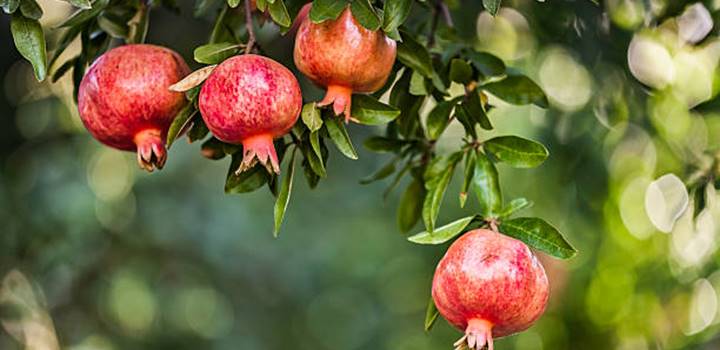Choosing the best fertilizer for your pomegranate is an uphill battle for sure. To choose the right one, you must know what your pomegranate requires.
Well, keeping Nitrogen in the middle, pomegranate requires a higher amount of potassium & a lower amount of phosphorus. But it also requires a continuous supply of nitrogen for vigorous growth. Moreover, a perfect fertilizer contains other macro & micronutrients.
There is plenty of fertilizer available in the market that meets the requirement of pomegranate.
Among them, I have listed the Recommended Fertilizers for your pomegranate tree.
Let’s check them out-
Top 8 Fertilizer For Pomegranate Tree-Comparisons
| Fertilizer | NPK | Form | Type | Price |
|---|---|---|---|---|
| Jobe’s Organics Fertilizer | 3-5-5 | Granular | Organic | |
| Jobe’s Organics Fertilizer | 3-5-5 | Spike | Organic | |
| Espoma Citrus-tone Plant Food | 5-2-6 | Granular | Organic | |
| Miracle-Gro Shake ‘N Feed | 8-2-10 | Granular | Synthetic | |
| Miracle-Gro Fruit Plant Food | 10-15-15 | Spike | Semi organic | |
| J R Peters Jacks Classic Fertilizer | 20-10-20 | Granular | Synthetic | |
| Down to Earth Organic Citrus Fertilizer | 6-3-3 | Granular | Organic | |
| Dr. Earth Fruit Tree Fertilizer | 5-5-2 | Granular | Organic |
Top 8 Fertilizer for Pomegranate Trees-Reviews
1. Jobe’s Organics Fruit & Citrus Fertilizer


Jobe’s Organics has contributed almost half a century to the eco-friendly fertilizing arena. Their year-long research & hard work pays off with some best fertilizers like Jobe’s Organics Fruit & Citrus Fertilizer.
It is an OMRI-listed product, which secures its suitability for organic production. Since the sources are feather meal, Bone meal. Processed poultry manure & Sulphate of Potash, we can’t doubt its organic nature.
Because of authentic organic sources & proper nutrient ratio, It is considered the best organic fertilizer for pomegranate.
Nutrient Composition
You know, plants require primary Nutrients(N, P, K) in large quantities. Its NPK ratio is 3-5-5. That means this fertilizer contains 3% of nitrogen, 5% phosphorus & 5% potassium.
It also contains Secondary Nutrients (Required in smaller amounts) such as Calcium (8%), Magnesium (0.5%), and Sulphur (1.6%).
Special Features
One of the best features is, it contains “Jobe’s BIOZOME”- a special combination of beneficial microbes (bacteria, Mycorrhizal fungi, and Archaea). This special ingredient helps to defend your garden from insects, diseases & drought. Enriches soil quality & favors plant growth.
Nitrogen is the most needed nutrient for plant growth, It increases fruit weight, color, stem strength & many more. As I said before that pomegranate needs more nitrogen than phosphorus & also a continuous supply.
But the NPK ratio of this fertilizer may confuse you as it has higher phosphorus than Nitrogen. Let me clear your confusion.
In this fertilizer, 1.8% nitrogen is water-insoluble. Water-insoluble nitrogen will slowly get soluble and ensure a continuous supply of nitrogen for around 2-3 weeks. Moreover, it won’t leach out easily like water-soluble fertilizers. That is why your pomegranate won’t be affected.
Applying Procedure
For inground pomegranate, sprinkle 3 cups of fertilizer per 1 inch of trunk diameter following the dripline & for potted pomegranate, Sprinkle 1/2 cup at the edges of 16-inch pot. After applying, mix the top soils gently & water thoroughly. Repeat it after 2-3 weeks.
2. Jobe’s Organics Fruit & Citrus Fertilizer Spike

Do you get tangled easily while measuring the fertilizer dose for your potted pomegranate? Well, don’t worry. Jobes Organics Fruit & Citrus Fertilizer Spikes can be a relief for you!
Nutrient Composition
The nutrients of this OMRI-listed organic fertilizer are derived from feather meal, bone meal & Sulphate of potash Its NPK ratio is 3-5-5. An expert opinion is It also contains some essential secondary nutrients that the manufacturer has not mentioned.
Special Features
Like the granular format, It has”Jobe’s BIOZOME” & both water-soluble & insoluble nutrients to secure an instant & continuous supply of them.
Additionally, premeasured nutrient spikes guarantee a precise supply of nutrients that your pomegranate tree needs. It also creates an easy feeding environment for the plant.
Applying Procedure
Use 2 spikes to push at the edges (1-2 inches below the ground) of your 12-inch diameter pot. The next due date is after 4-5 weeks. Until then- relax!
3. Espoma Citrus Tone 5-2-6 Plant Food

Are you searching for the best natural fertilizer for your pomegranate tree? Consider Espoma Citrus Tone 5-2-6 plant food without further thinking.
With long-lasting slow-release feeding, Espoma Citrus Tone ensures larger & flavorful pomegranate.
Nutrient Compositions
Nutrients are derived from organic sources, such as feather meal, bone meal, humates, alfalfa meal, poultry manure, Greensand, Sulphate of Potash & Sulphate of Potash Magnesia. Its NPK ratio is 5-2-6. It also contains secondary Nutrients- Calcium (2%), Magnesium (0.5%), and Sulphur (1%).
Special Features
Espoma Organic’s “BIO TONE”. It is a blend of beneficial microbes to enhance & support soil activity.
Citrus Tone contains 3% water-insoluble nitrogen. It ensures the slow release of nitrogen continuously for a longer period. I bet your pomegranate will love you for this!
Applying Procedure
Inground pomegranate requires 6 cups of fertilizer per 3 feet of plant length at the drip line & potted pomegranate requires One teaspoon per 4″ of pot diameter at the edges.
After applying, work into the soil & water thoroughly. Repeat the application after 2 months.
4. Miracle-Gro Shake ‘N Feed Citrus, Avocado, Mango Plant Food
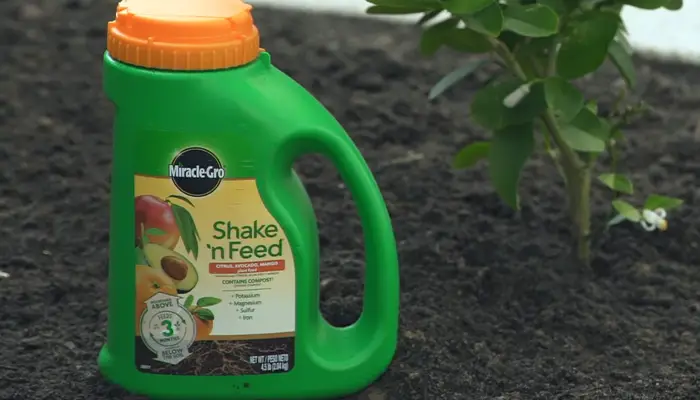
“Nourishes Above & Below the soil” – the tagline of Miracle-Gro. Well, it is certain! Because of its complete nutrient package, it is one of the best foods for pomegranate.
Nutrient Composition
It is an inorganic fertilizer. All the nutrients are derived from inorganic sources that are safe for plants.
Its NPK ratio is 8-2-10. Other nutrients are-
Secondary nutrients– Calcium (6.9 %), Magnesium (5.5%), Sulphur (4.7%)
Trace elements (Required in very small amounts)- Iron (0.92%), Copper (0.05%), Manganese (0.34%), Zinc (0.11%).
Special Features
It contains 4.14% & 1.74% of coated nitrogen & available phosphate. Coated Nutrients released slowly ensure a continuous supply of them. So, With so many nutrients, both coated & free, tell me what else your pomegranate requires?
Application Procedure
For inground pomegranate, Shake 13/4 tablespoon onto per 4 square feet of soil. Then work into the top 1-3 inches of the soil & water thoroughly.
For potted pomegranate, shake 1 tablespoon onto the soil of a 10″ pot evenly. Light soil working & thorough watering is needed.
5. Miracle-Gro Fruit & Citrus Plant Food Spikes

Well, Miracle-Gro strikes again! Are you looking for the best spike fertilizer for your pomegranate? Give this fertilizer a try. Its advanced composition will definitely make your pomegranates juicy!
Nutrient Composition
The nutrients of these spikes are extracted from ammonium sulfate, feather meal, bone meal, ammonium phosphate, potassium chloride, sulfate of potash, magnetic rocks, and manganese sulfate
As both organic & inorganic sources are providing nutrients, you can call it semi-organic fertilizer.
The NPK ratio of these spikes is 10-15-15. It also contains secondary Nutrients- Sulphur (8%) &
trace elements – Iron (0.1 %) , Manganese (0.005%).
Special Features
The easy handling process is a prime specialty of these spikes. As most of the nutrients are water-soluble, Spikes contain a higher amount of potassium & phosphorus to check the runoff.
The iron & manganese precisely defend pomegranate from chlorosis. Moreover, It contains natural ingredients needed for soil microbes.
Applying Procedure
These spikes are mainly for inground pomegranates. Simply Push the spikes 1-3 inches down to the surface following the dripline & maintain 3 feet distance from the tree center. & remember to moist your soil before applying.
Apply these spikes twice a year. Once in spring & once in fall. Easy, right?
6. J R Peters Inc Jacks Classic Citrus Food Fertilizer

If you prefer water-soluble fertilizers, this one’s for you. J R Peters Inc.’s citrus food fertilizer is one of the best water-soluble fertilizers because of its optimum nutrient composition.
Nutrient Composition
All the Nutrients of this fertilizer are derived from safe inorganic sources. Its NPK ratio is 20-10-20.
It also contains secondary Nutrients– Magnesium (1%), Sulphur (4.9%) & trace elements- Boron (0.02%), Copper (0.05%), Iron (0.15%), Manganese (0.075%), Molybdenum (0.009%) & Zinc (0.05%)
Special Features
With a high NPK percentage, this water-soluble fertilizer contains all the micronutrients that pomegranate needs from a young age. It is one of the best liquid fertilizers for the young pomegranate tree.
Applying Procedure
Being a water-soluble fertilizer, it releases nutrients early & nutrients tend to run off easily. That’s why it requires a frequent application after every 7-10 days.
For application, Mix 1 tablespoon of fertilizer into 4 liters of water. You can apply it directly to the soil or foliage!!
7. Down to Earth Organic Citrus Fertilizer Mix

Down to earth organic citrus fertilizer is one of the best organic fertilizers in the market. As it is OMRI listed & maintains the proper ratio of NPK to promote plenty of fruit, you may consider it for a try.
Nutrient Composition
Organic sources like Feather Meal, Fish Bone Meal, Alfalfa Meal, Langbeinite, Basalt, Potassium Sulfate, Zinc Sulfate, and Kelp Meal have supplied the nutrients of this fertilizer.
Its NPK ratio is 6-3-3. It also contains secondary nutrients- Calcium (3%), Sulphur (2%) & trace elements- iron (0.5%), Zinc (0.5%)
Special Features
All of its nitrogen is water-insoluble !! Can you believe it? Slow & continuous release of nitrogen is exactly what your pomegranate tree needs!
Moreover, 2.5% humic acid increases the nutrient uptake capacity of the soil. I must say it is a rare combo, isn’t it?
Applying Procedure
For inground pomegranate, sprinkle 1 cup per 1-inch tree trunk following the dripline & for potted pomegranate, apply 2-4 tablespoons per gallon of soil. Repeat it after 3-4 months.
8. Dr. Earth Organic & Natural MINI Natural Wonder Fruit Tree Fertilizer
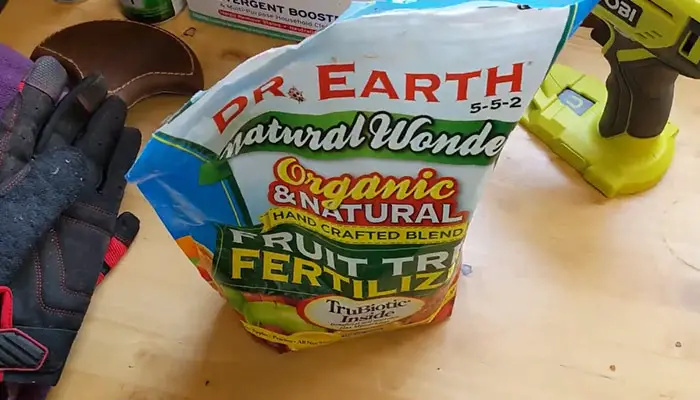
Dr. Earth’s organic fruit tree fertilizer is truly a natural wonder! This OMRI-listed fertilizer enhances soil’s capability to grow healthy pomegranates.
Nutrient Composition
The nutrients are extracted from the organic sources-feather meal, fishbone meal, bone meal, alfalfa meal, potassium sulfate, kelp flour, rock phosphate, and kelp meal.
It has an NPK ratio of 5-5-2. It also contains some quantities of secondary nutrients which are not mentioned by the manufacturer.
Special Features
All 5% of the nitrogen is water-insoluble. It is an absolute composition for nitrogen lovers like pomegranate,
In addition to it. 9% Humic acid is present which acts as a natural plant growth stimulator!!
It also contains “TruBiotic”- a blend of biological soil inoculants to enhance soil fertility & disease resistance.
Applying Procedure
Apply one cup per inch of trunk diameter following the dripline. After applying, gentle soil working & thorough watering is highly recommended. The next due date is 3-4 months later.
What Food Does Pomegranate Trees Need?
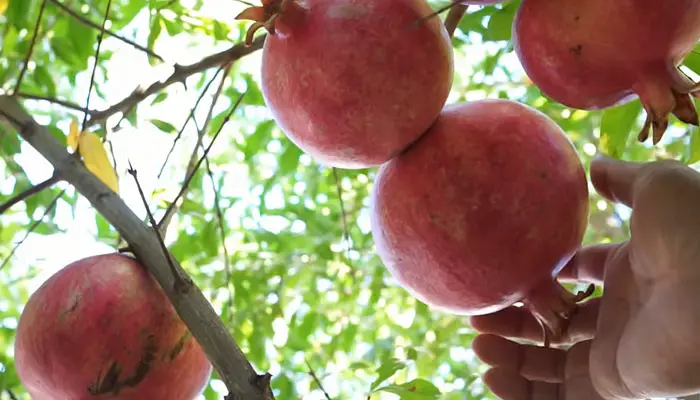
Juicy pomegranates of neighbors often raise that inevitable question in our mind-“what does he feed to the pomegranate tree”!
Well, like every other tree, pomegranate requires nutrients to grow at its best. You know, Nitrogen, phosphorus & potassium are three major nutrients for pomegranate. Nitrogen secures proper growth while phosphorus & potassium secures sounder flowering & fruiting respectively!
Among them, Nitrogen is the most required one. Because for better flowering & fruiting, your pomegranate needs proper growth of foliage to cook required food!
Other nutrients for example- calcium, magnesium, sulfur, boron, Manganese, etc have also supporting roles such as green coloring of plants, cell wall development, disease resistance, etc
When to Fertilize Pomegranate?
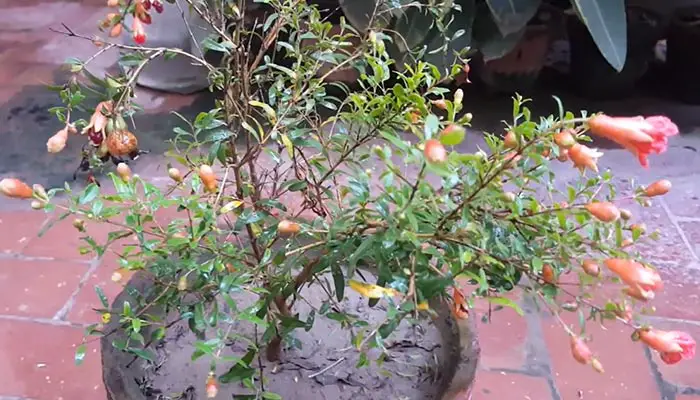
Do you maintain a fertilization schedule? I hope you do! It is best to start the fertilization at the growing period of your pomegranate. You will notice some new growth between January & February. They need extra food at that time. I am giving you a proper fertilization schedule that I also follow-
January & February: Fertilizing will help your pomegranate to bloom.
May & June: Triggers lots of fruit set.
August & September: Fulfills the demand for nutrients precisely.
Apart from scheduled fertilizing, you must observe your pomegranate tree frequently to identify deficiency of nutrients & to provide fertilizer accordingly.
How To Fertilize Pomegranate Trees?
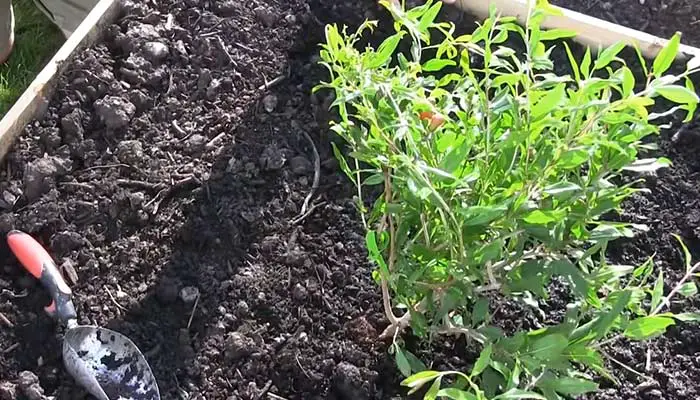
You already know that there are mainly three types of fertilizers available in the market- Granular, Liquid, or Water-soluble & spike. Each of them requires different types of applying procedures.
Granular fertilizer
Steps-
- After measuring dripline, trunk diameter, or pot size, prepare exact doses to apply.
- Remove some upper soils from the dripline or edges of the pot & sprinkle the exact dose of fertilizer on that area.
- Replace the removed soil over the fertilizer & mix them properly
- Water thoroughly
Liquid /Water-soluble fertilizer
Steps-
- Make the fertilizer solution according to the provided direction.
- Pour the exact dose at the base of your pomegranate tree. But wait, check if it prefers foliar application.
Spike fertilizer
Steps-
- Select the number of spikes needed according to the direction.
- Push the spikes 1-3 inches down to the surface at the edges of the container or around the dripline
Homemade Fertilizer for Pomegranate
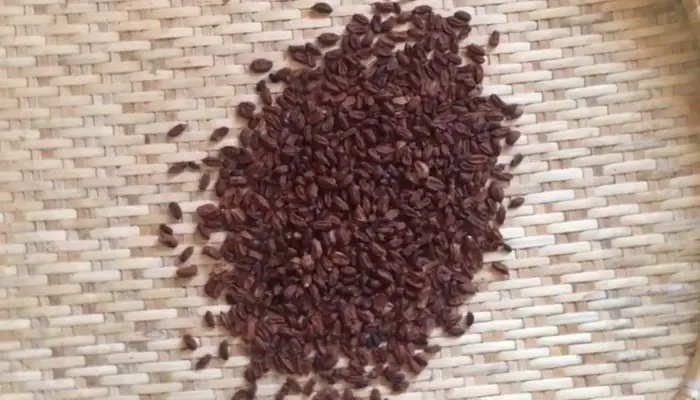
We often think about how to increase the fruit size of my pomegranate.
You know, Light pruning can help to get king-sized pomegranates. But there is homemade fertilizer that also has the potential. I am sharing the recipe with you. You can thank me later!
Required Items
- Bucket (25-liter water holding capacity)
- Cow dung manure (4 kg)
- Mustard cake (1 kg)
- Neem Cake (1 kg)
- Plain yogurt ( 0.5 liters)
- Jaggery (250 gm)
- Water
Steps
- Pour all the items in the 25-liter bucket
- Fill the bucket with water
- Mix them properly
- Let the solution stay for 3-4 days for proper fermentation.
Your homemade organic fertilizer is ready. Before applying, it should be diluted again with water. After applying, provide mulch to the base of your pomegranate tree. Repeat this application after every three months.
Frequently Asked Questions
#Do Pomegranate Trees Need A Lot of Water?
Newly planted pomegranate trees do require lots of water for their development. Sometimes once or maybe twice a day depending on temperature, wind, and soil conditions. But remember that, the soil should be moist but not soggy.
On the other hand, once they are developed they are pretty much drought tolerant. So watering can be done once every 10 days.
#Are Coffee Grounds Good For Pomegranate Trees?
Yeah! It’s true! Coffee grounds can be good for pomegranate trees if used in the right way.
They add nutrients like nitrogen and help in pomegranate growth and development. Moreover, they retain more water and provide more aeration when added to the soil. Coffee grounds repel pests like worms and snails. What a better way to use your garbage to your advantage!!
#Is Epsom Salt Good For Pomegranate?
Epsom salt is actually magnesium sulfate. It’s mostly used for magnesium deficiencies.
The right amount of Epsom salt can help the pomegranates to absorb other nutrients like nitrogen and phosphorus more efficiently. Pomegranates respond very well to Epsom salts when it comes to fruit production. An uplift of Magnesium results in sweeter and better pomegranate.
#Is Chicken Manure Good For Pomegranate?
Yes! Chicken manure is a brilliant choice of compost material for pomegranates. But raw chicken manure is rich in ammonia which supplies excess nitrogen to pomegranates. Excess nitrogen will focus on vegetative growth rather than making the pomegranates delicious.
On the other hand, when it’s mixed with the compost, excess ammonia evaporates and provides the right amount of nitrogen.
Conclusion
Juicy harvest from a pomegranate tree is just a matter of time if you take care of it properly. Even the best fertilizer of pomegranate may not work if you fail to provide it at the right time.
In this article, I have covered these issues with proper solutions. I hope you will find it helpful.
Happy Gardening!
